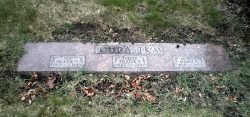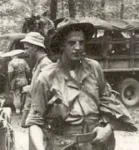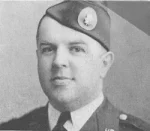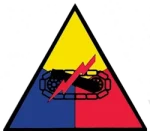S/Sgt. Frank Thurston Chrastka Jr. was born on March 3, 1925, in Chicago, Illinois, to Frank T. Chrastka Sr. and Mable V. Thurston-Chrastka. With his two sisters and brother, he grew up at 843 Circle Avenue, Forest Park, Illinois. He graduated from grade school in Forest Park and was a member of the Proviso Township High School 1943 graduating class. While he was in high school, on March 3, 1943, he registered with Selective Service since the draft age had been lowered to 18 years old, and named his father as his contact person.
Frank was inducted into the US Army on June 21, 1943, in Chicago. He was issued the Serial Number 36 725 671. It is not known where he did his basic training, but because of his scores on the Army General Classification Test, he was assigned to the Air Corps. He B-17 crew training at Avon Army Airfield, Florida, gunnery school training as a tail gunner at Tyndall Airfield, Florida, and training at Savannah Army Airfield, Savannah, Georgia. It is believed he joined the 832nd Bombardment Squadron, 486th Bombardment Group, 8th Air Force, in Savannah. He was most likely sent overseas as a member of a replacement crew.
What is known of his time in England is that he was a member of Capt. Ronald E. Bereman’s crew and that the crew flew over 20 missions together. Frank was put into the pool of available men to replace an ill or wounded member of another crew. With him was his friend, S/Sgt. Johnnie L. Jones who also had flown with Bereman. This mission was his 35th, as well as the final mission. He was selected to fly with the crew of Lt. Lewis Cloud in his plane, the “Blue Grass Girl.” As it turned out, the entire crew of the plane were also on their final mission.
As part of a formation of 1,003 B-17s, the plane successfully completed its bombing mission over Berlin, on February 3, 1945, and was approaching the airfield at Sudbury, England. It was stated Frank and other crewmen had gathered in the radio compartment and that his parachute was eight to twelve feet from him. A radio message stated the crew was celebrating to an extent.
What happened next is a mystery. The plane suddenly burst into flames because the plane was being fed by a broken oxygen line. The pilot of another plane stated that the Blue Grass Girl was flying normally when suddenly there was fire pouring out the rear of the plane. It was said that long streaks of fire shot from the waist gunner windows. Rumors circulated that someone in the plane celebrating that the war was over for them, shot off a flare inside of the plane resulting in the plane catching fire. Frank was one of the crew members who could not reach his parachute. One surviving member said he believed the fired started behind the ball turret. The fire was so intense that it was believed most of the men in the rear of the plane died quickly. Four of the members parachuted out of the plane safely. Another man was killed because when he jumped he was too close to the ground and his chute never opened. Frank was one of the four crew members, which included the pilot, who died on the plane on February 3, 1945. The fire melted the cables that controlled the flaps and rudder, and the plane dove and slammed into the ground.
After Frank’s body was recovered this report was filed from the 486th Bombardment Group dental surgeon it was stated:
4 February 1945
SUBJECT: Special Report.
TO : The Surgeon, Eighth Air Force, APO 634, U, S, Army
1. In compliance with memorandum # 25-17, dated 25 June 1944, a special report is hereby submitted on air craft accident, where the use of Flying Personnel Dental Identification Form was necessary to identify body.
(1) On February 3, 1945 at 1515 hours in the vicinity of Southwold, Suffolk, England, during an operational mission, a fire occurred in the waist of B-17 aircraft from this station. Said fies was not discovered until it was unmanageable. Aircraft went out of control and crashed. Five members of the crew were crushed and burned. One crewmember was in such condition that identification by means other than Dental Identification Record was impossible. This identification was accomplished at this station. The deceased crewmember, on whom the identification by mean of a Dental Record was accomplished was:
S/Sgt. Frank T. Chrastka, 36752671, 832nd Bomb Squadron. Cambridge Y – 4 – 10
(2) Number of individuals involved, nine.
(3) Diagnosis for deceased was, multiple fractures and partial cremation.
(4) Number of individuals identified by dental examination, one
(5) Number of individuals identified without use of dental records, four
(6) Flying Personnel Dental Identification Forms for deceased personnel involved in accident, are submitted herewith.
(signed)
THOMAS PRINGLE
Capt., DC
Station Dental Surgeon
Frank was buried on February 6, 1945, in the Cambridge-American Military Cemetery in Plot Y, Row 4, Grave 10. The man buried to the right on him, Sgt. Gus T Hodge, in Grave 11, was a member of the plane’s the crew.
Frank’s parents were sent a telegram from the War Department, Washington DC, on February 16, 1945.
MABEL CHRASTKA
843 SOUTH CIRCLE AVENUE
FOREST PARK ILLINOIS
THE SECRETARY OF WAT DESIRES ME TO EXPRESS HIS DEEPEST REGRET THAT YOUR SON STAFF SERGEANT FRANK T CHRASTKS JR WAS KILLED IN ACTION ON THREE FEBRUARY IN ENGLAND LETTER FOLLOWS
ULIO THE ADJUTENT GENERAL
A letter was also sent as a follow up to the telegram, but its content is not known.
In a letter dated February 12, 1946, his parents were informed of where he was buried and the location of his grave in the cemetery. They were also informed that the cemetery was constant care and supervision. A year later on February 4, 1947, another letter with a photo of the cemetery where Frank was buried. The letter also stated that the cemetery was a temporary site and those buried there would be moved to a permanent American Military Cemetery or returned to the United States. It appears that a form was sent in the letter that they were given the options available to them for Frank’s final burial. They were asked to fill-out and return an enclosed form indicating where they wanted Frank buried. The form was filled out and returned to the Office of the Quartermaster General, Washington DC, on May 12, 1947. It indicated his parents wanted his remains returned to the United States.
Frank’s casket was disinterred, on April 15, 1948, and taken by train to Cardiff South Wales. They were held there by the American Graves Registration Service until June 16th, when they placed on the USAT Lawrence Victory. The ship sailed the same day and arrived in the New York Port of Entry on June 23rd. It appears his casket was held at the NYPE until June 30th when they were sent by train to the Quartermaster Corps Distribution Center #8, Chicago, Illinois. In a military, hearse his casket was taken to the John T. Chrastka Funeral Home in Berwyn, Illinois, on August 3, 1948.
S/Sgt. Frank T. Chrastka was buried on August 3, 1948, in Woodlawn Cemetery, Forest Park, Illinois. He was awarded the Air Medal with four oak leaf clusters, the European Theater Medal, the Good Conduct Medal, and the Purple Heart. S/Sgt Frank Chrastka is one of the key figures in the book, “Mission to Berlin”








